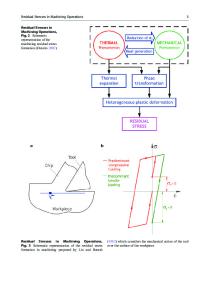Residual Stresses in Friction-Stir-Welded 2195 and 7075 Aluminum Alloys
- PDF / 771,738 Bytes
- 8 Pages / 593.972 x 792 pts Page_size
- 110 Downloads / 313 Views
DUCTION
FRICTION stir welding (FSW) was invented by The Welding Institute in England in 1991.[1] Since its invention, FSW has emerged as a promising solid-state process capable of welding aluminum alloys (AAs) with encouraging results.[2] Friction stir welding uses a nonconsumable cylindrical pin that rotates at high speeds and plunges into butting edges of the work pieces to be joined.[3] The tool rotation stirs and mixes the material around the rotating pin, and the translation of the tool moves the stirred material from the front to the back of the pin during welding. The process uses frictional heating combined with forging pressure to produce high strength bonds. In fusion welding, complex thermal and mechanical stresses develop in the weld and the surrounding areas. It is common for residual stresses (RSs) in fusion welds to approach the yield strength of the base material. On the other hand, FSW takes place at a lower temperature level; therefore, RSs may be considerably less than those in fusion welds. However, the heating cycle the material experiences during welding and the rigid clamping arrangement used in FSW can have an impact on RSs in the weld. The rigid clamping arrangement used in FSW generally imposes higher restraints on the welded plates than the more compliant clamps used for fixing the parts during conventional welding processes.[2,4] The RSs in welded components can have a substantial effect on the service performance to fatigue crack growth process and fatigue life.[5] The RSs in the FSW joints and surrounding material will therefore play an important role in determining the durability of the welds OMAR HATAMLEH, NSE/Research Scientist, is with the Structures Branch, NASA—Johnson Space Center, Houston, TX 77058. Contact e-mail: [email protected] IRIS V. RIVERO, Associate Professor, and ARIF MAREDIA, Graduate Student, are with the Department of Industrial Engineering, Texas Tech University, Box 43061, Lubbock, TX 79409-3061. Manuscript submitted December 9, 2007. Article published online October 9, 2008 METALLURGICAL AND MATERIALS TRANSACTIONS A
and will be fundamental in influencing the welded structure integrity and performance. Consequently, it is very important to understand the RSs and their effects on the structural failure of FSW structures. In this study, the effects of FSW on RSs were investigated for the 2195 and 7075 AAs using X-ray diffraction (XRD). To establish a complete RS profile and investigate the changes as a function of weld distance, the profiles were taken at five different distances from the start of the weld along the weld line. Each location along the weld consisted of several weld regions across the weld. These locations corresponded to the weld nugget, thermomechanically affected zone (TMAZ), heat-affected zone (HAZ), and base material on both sides of the weld. Residual stresses at the back face of the welded plate were also characterized.
II.
EXPERIMENTAL PROCEDURE
The starting materials for this investigation were 1.25-cm thick for the AA 2195 and slightly thicke
Data Loading...











